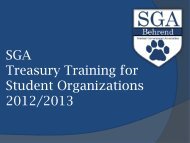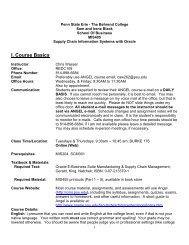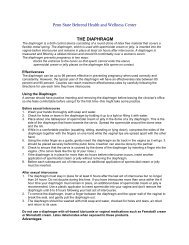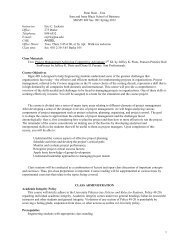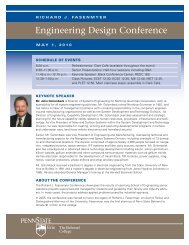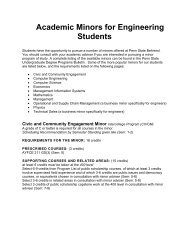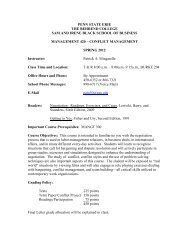Volume 3, Number 1 - Penn State Erie
Volume 3, Number 1 - Penn State Erie
Volume 3, Number 1 - Penn State Erie
You also want an ePaper? Increase the reach of your titles
YUMPU automatically turns print PDFs into web optimized ePapers that Google loves.
The Arboretum at <strong>Penn</strong> <strong>State</strong> Behrend<br />
<strong>Penn</strong> <strong>State</strong> <strong>Erie</strong>, The Behrend College<br />
4215 Station Road<br />
<strong>Erie</strong>, PA 16563-0107<br />
Printed on recycled paper<br />
Ethel Kochel Garden Dedicated<br />
Ethel Kochel was the guest of honor at the surprise<br />
October 5, 2007 dedication of the Ethel Kochel Garden,<br />
the newest addition to the Arboretum at <strong>Penn</strong> <strong>State</strong> Behrend.<br />
Jeffrey Kochel ’71 AGR and his wife Pamela Olson<br />
Kochel ‘73 LIB, commissioned the garden as a tribute<br />
to his mother. At the suggestion of Mary Beth McCarthy,<br />
<strong>Penn</strong> <strong>State</strong> Master Gardener and director of the College’s<br />
Center for Career Development, the Kochels chose to<br />
renovate the patio area located on the west side of the<br />
building that is dedicated to his father, Irvin Kochel.<br />
As designed and planted by Dahlkemper Landscape<br />
Architects and Contractors, it features a Skyline<br />
(Sunburst) honey locust tree and ornamental grasses<br />
including ‘Karl Foerster’ feather reed grass. An acidstained<br />
pattern enhances the existing paving. Two new<br />
metal picnic tables allow students, faculty, and staff the<br />
opportunity to study, relax, or dine al-fresco.<br />
The highlight of the garden, however, is a collection<br />
of dwarf conifers, a favorite of Mary Behrend. The<br />
fifteen species of conifers include: Pinus strobus ‘Nana’,<br />
Pinus strobus ‘Contorta Nana’, Pinus strobus ‘Hershey’,<br />
Pinus strobus ‘Horsford’, Pinus strobus ‘Pendula’, Pinus<br />
strobus ‘Torulosa’, Pinus mugo mugo, Pinus mugho<br />
purmillo, Microbiota decussate, Picea abies pumilla,<br />
Chamaecyparis p. filfera ‘Sungold’, Picea mariana<br />
‘Ericoides’, Dwarf globe blue spruce, Chamaecyparis<br />
obtusa gracilis, and Picea abies nidiformis.<br />
Mrs. Kochel is the widow of the late Irvin Kochel who<br />
served as the director of <strong>Penn</strong> <strong>State</strong> Behrend from 1954<br />
until 1980. When the family first arrived on campus they<br />
lived on campus, in an old farmhouse, and Mrs. Kochel<br />
became fond of Behrend property. According to Jeff<br />
Kochel, “my mother has always been interested in the<br />
campus grounds and was concerned about retaining the<br />
‘country feel’ of Behrend as it expanded under my father’s<br />
leadership. She supported my father in many ways during<br />
Behrend’s development. It just seemed to fit to bring<br />
all this together in a garden that represents Pam and my<br />
appreciation for the Behrend grounds and highlights<br />
a section of the building named after my father with a<br />
garden honoring my mother. This recognizes her support<br />
‘behind the scenes’ for my father, and her love of nature.”<br />
Jeffrey Kochel is employed at Forest Investment Associates<br />
in Smethport, providing timberland investment<br />
and management services to individual and institutional<br />
investors, and corporations. As a student he worked<br />
summers on the Behrend grounds crew. Says Mr. Kochel:<br />
“Since my wife and I both enjoy the beauty of the<br />
campus and think this is an important asset for Behrend,<br />
we were interested in doing something to help with the<br />
development of the new arboretum.”<br />
Back row: Irvin Kochel III<br />
(’75 SCI), Pamela Olson<br />
Kochel (‘73 LIB), Jeffrey<br />
Kochel (’71 AGR), Terry<br />
Young<br />
Front Row: Carla Kochel<br />
(’75 HHD), Ethel Kochel,<br />
Patty Kochel Young<br />
Quirky Quercus<br />
VolUmE 3 NUmbEr 1 | SprINg 2008 | www.greencampus.psu.edu<br />
Oaks are flowering plants belonging to the genus<br />
Quercus, the Latin name derived from two<br />
Celtic words: quer, meaning fine and cuez,<br />
meaning tree. In the same family are beeches (genus<br />
Fagus) and chestnuts (genus Castanea); only the oaks<br />
produce acorns. The only other genus producing acorns<br />
is Litliocarpus, the tanbark oak.<br />
These trees are set apart by four characteristics: a<br />
fruit known as the acorn; a distinctive, wind-pollinated<br />
flower; a strong, complex wood; and an ability to live for<br />
many decades, if not centuries. The acorn, producing<br />
female flowers, are scattered singly or in small groups<br />
among the youngest twigs The pollen-producing male<br />
flowers are clustered on pendulous threads known as<br />
catkins. A male flower has five to 12 stamens that make<br />
the pollen and between 25-100 male flowers form a<br />
catkin and each tree bears thousands of catkins in a<br />
single year.<br />
Typically the genus Quercus is divided into two major<br />
groups: red and white. Both have lobed leaves with the<br />
red oak lobes bristle-tipped while the white oaks have<br />
rounded lobes. Other obvious differences are in the<br />
acorns. Red oak acorns require two years to mature while<br />
white oaks mature in one season (annuals). Red oak acorn<br />
cups have velvety hairs on the inner surface. Another<br />
feature that the wine industry has taken advantage of is<br />
that the heartwood of white oaks have clogged vessels<br />
(part of the anatomy of wood) that makes them impervious<br />
to liquids. White oak barrels make up the cooperage<br />
industry. Because red oaks have open vessels and easily<br />
absorb wood preservatives, they are used in oak flooring.<br />
White oak evolutionary lineage has rounded lobes,<br />
not pointed. Tips of the lobes and the rest of the leaf<br />
margin (edge) may have teeth or spines, not bristles.<br />
Teeth are green leaf tissue drawn to a point along the<br />
margin. If the point is hard and very sharp it is called a<br />
spine. Bristles are dry, colorless extensions of a leaf vein<br />
that go beyond the margin. Acorns of white oaks ripen<br />
in one year and the scales of the acorn are knobby.<br />
Red oak evolution, sometimes called black, has<br />
deeply lobed leaves or unlobed, oval leaves. Lobes or<br />
margins of the leaves are tipped with tawny bristles that<br />
extend beyond the green of the blade. Acorns typically<br />
take 2 years to ripen, with the exception of the coast<br />
live oak of California. Its acorn scales are thin and flat,<br />
covering the acorn like shingles.<br />
But what seems not to fit into the oak leaf formula<br />
are those oak leaves without any lobing or which have<br />
serrated margins instead. The following “red oaks” have<br />
elliptical leaves with smooth (entire) margins: Quercus<br />
imbricata (Shingle Oak) and Quercus phellos (Willow<br />
Oak). At least six more southern oaks also could be<br />
included here. An odd form of lobing occurs in another<br />
“red oak” the Quercus marilandica (Blackjack Oak).<br />
The “white oaks” that are not lobed appear to have<br />
serrated margins in the following species: Quercus<br />
michauxii (Swamp Chestnut Oak) which sports a wavy<br />
margin in 9-14 rounded teeth and Quercus muehlenbergii<br />
(Chinkapin Oak). Other” white oaks” have very<br />
shallow lobes or an entire margin such as: Quercus bicolor<br />
(Swamp White Oak) and Quercus prinodes (Dwarf<br />
Chinkapin Oak). Many of these listed above can be found<br />
in the Arboretum at <strong>Penn</strong> <strong>State</strong> Behrend.<br />
Ed Masteller, Ph.D., professor emeritus of biology,<br />
may be contacted at e11@psu.edu.<br />
Quercus alba. White oaks<br />
have leaves with rounded<br />
lobes. Their acorns, producing<br />
female flowers,<br />
are scattered in small<br />
groups among the youngest<br />
twigs.<br />
IN THIS ISSUE<br />
Remembering Aldo<br />
Leopold 2<br />
The Revival of the<br />
Ameican Chestnut 3<br />
? 4<br />
This publication is available<br />
in alternative media upon<br />
request.<br />
<strong>Penn</strong> <strong>State</strong> is committed to<br />
affirmative action, equal opportunity,<br />
and the diversity of<br />
its workforce.<br />
U.Ed. EBO 08-xx<br />
For information about the<br />
arboretum call 814-898-6160
Sand County<br />
Almanac is the<br />
2008 choice<br />
for One Book,<br />
One <strong>Erie</strong><br />
Remembering Aldo Leopold<br />
We approach the sixtieth anniversary of the<br />
death of Aldo Leopold (1887-1948). His<br />
legacy lies in our attitudes towards nature.<br />
We expect our visit to an arboretum to be an experience<br />
of learning and spiritual enrichment. Earlier generations<br />
may have seen timber, pulp, or employment in trees.<br />
They still may, but for many the uses of trees are inseparable<br />
from our conviction that we need a sense of beauty,<br />
an ethic of conservation, and knowledge of the world we<br />
did not create. What we may forget is that our sense of<br />
wonder grows from the achievements of persons whose<br />
name and works are less well known. Typically they<br />
include such names as Sweden’s Carl Linnaeus (1707-<br />
1778), an inventor of modern scientific nomenclature<br />
and Rachel Carson (1907-1964), a marine biologist<br />
whose book, Silent Spring, helped<br />
make us sensitive to the fragility of<br />
nature. Like Carson, Leopold became<br />
best known for a single work, Sand<br />
County Almanac, one that has never<br />
gone out of print and remains a pioneering<br />
work of nature writing.<br />
Leopold’s biography understates<br />
the impact of his ideas. He developed<br />
a sense of nature as an interdependent<br />
community, a “land ethic,” in which human<br />
intervention demands a knowledge<br />
and responsibility beyond any economic<br />
purpose. Of course, the objective of a<br />
sustainable relation among humans,<br />
plants, and animals is the only one that has economic<br />
justification, yet Leopold’s vision is one which recognizes<br />
the integrity of living things. He especially mourned the<br />
disappearance of wolves and grizzly bears and the need to<br />
set aside areas of roadless wilderness in the West. In his<br />
words, “relegating grizzlies to Alaska is about like relegating<br />
happiness to heaven; one may never get there.” One<br />
suspects Leopold’s conviction was a result of his gift of<br />
powerful observation. He was born near Burlington, Iowa<br />
near the Mississippi at a time when some of the original<br />
prairie survived, and because of his parents emphasis<br />
on education, he enjoyed a privileged secondary education<br />
that brought him to graduate from Yale School of<br />
Forestry.<br />
Employed by the US Forestry Service, Leopold spent<br />
his first assignment in the US territory that would become<br />
the state of Arizona. He would also work in New Mexico’s<br />
Gila National Forest, part of which was set aside for the<br />
Aldo Leopold Wilderness. In 1924, Leopold became<br />
Director of the Forest Products Laboratory in Madison,<br />
Wisconsin. Less than a decade later, at a time of dust<br />
bowl drought, he lent his expertise to a project of the<br />
Department of Agriculture’s newly formed Soil Erosion<br />
Service. The 1933 watershed demonstration project for<br />
soil erosion at the town of Coon Valley in southwestern<br />
Wisconsin proved the value of more deliberate farming<br />
practice. The project also laid a basis for the work of the<br />
Civilian Conservation Corps. In 1935, after joining the<br />
faculty at the University of Wisconsin, Leopold purchased<br />
a run down farm that became a model of natural<br />
restoration and conservation available to his students and<br />
a source of inspiration for Sand County Almanac.<br />
It is hardly surprising that Leopold’s writing about<br />
trees emphasized their role as sentinels of other natural<br />
events. One of his essays “Good Oak” mourns a great oak<br />
of 30” in diameter with some eighty rings. The tree was<br />
struck down by lightning at Leopold’s beloved farm. His<br />
use of its fire wood made him reflect as he cut through the<br />
rings. Leopold notes that about the time of the tree’s germination<br />
in 1865 there was evidently a scarcity of rabbits,<br />
since the seedling survived. He starts at the “dust bowl<br />
droughts” of the 1930s on the “Babbittian” decade of the<br />
1920s when everything grew bigger and better in heedless<br />
arrogance and the decade after 1910 “when steam<br />
shovels sucked dry the marshes of central Wisconsin to<br />
make farms, and made ash heaps instead.” The years of<br />
fierce fire and drought alternate with some of the greater<br />
sadness of extermination. When on September 10,<br />
1877, “two brothers shooting at Muskego Lake, bagged<br />
210 Blue-winged Teal in one day, and in 1876 four<br />
hunters killed 153 Prairie Chickens, and one Chicago<br />
firm received and marketed 25,000...”. “In 1871, within<br />
a 50-mile triangle spreading northwestward from my oak,<br />
136 million Passenger Pigeons nested...” in their largest<br />
concentration before confronting extinction .<br />
In the essay “December,” Leopold takes special joy<br />
in the “candle” of new growth in the pines. “In fact every<br />
Pine carries an open bankbook in which his cash balance<br />
is recorded by June 30 of every year. If, on that date, his<br />
completed candle has developed a terminal cluster of ten<br />
or twelve buds, it means that he has salted away enough<br />
rain and sun for a two-foot or even three-foot skyward<br />
next Spring.” There is abundant evidence of the genius<br />
that prompted Leopold’s observation and his testimony.<br />
Perhaps the best way to bring it honor is to recall his belief<br />
that “we can be ethical only in relation to something we<br />
can see, feel, understand, love, or otherwise have faith<br />
in.” Surely the great natural beauty that is <strong>Penn</strong>sylvania’s<br />
heritage makes imperative such a relation.<br />
Zachary T. Irwin, Ph.D., associate professor of political<br />
science, may be contacted at zti1@psu.edu.<br />
The Revival of the American Chestnut<br />
At the beginning of the 20th century the American<br />
chestnut (Castanea dentata) trees at the<br />
New York Zoological Garden began to die because<br />
of a fungal infection that would girdle the trunks<br />
and choke off the vascular system. By mid-century the<br />
fungus, now described as the chestnut blight (Cryphonectria<br />
parasitica), spread throughout the range of<br />
the American chestnut, and the result was an ecological<br />
disaster. Millions of acres of forest in the eastern United<br />
<strong>State</strong>s were decimated and the American chestnut, once<br />
a dominant tree in large portions of the Appalachian<br />
Highlands, was reduced to a minor species in the ecosystem.<br />
The fate of the American chestnut tree became<br />
an example of the environmental havoc and ruin that can<br />
result from the introduction of a non-native species.<br />
The American chestnut tree was of great economic<br />
and ecological value. It was fast growing and the wood<br />
was highly valued for construction because of its<br />
resistance to rot. The nuts, or mast, were a major food<br />
source for many forest species and they were highly<br />
prized for human consumption. Roasted chestnuts,<br />
chestnut stuffing, cakes, and breads were typical fare in<br />
American cuisine. All of that changed with the introduction<br />
of the chestnut blight. Huge swaths of Appalachian<br />
forest were transformed as chestnut trees died and were<br />
replaced with other species such as oak and maple.<br />
From Ontario to Alabama, and from Maine to Illinois,<br />
the American chestnut was reduced to an insignificant<br />
plant that survived by sprouting from stumps or in a few<br />
isolated stands that escaped disease. Even today the<br />
American chestnut survives in the forest by sprouting<br />
from the old stumps left after the initial dieback.<br />
The sprouts rarely reach tree size because the fungus<br />
re-infects, but an occasional tree reaches maturity and<br />
sets seed. However, the American chestnut is no longer<br />
a significant species in the North American forest, it<br />
is no longer a commodity for the timber industry, and<br />
the edible chestnuts sold in stores are not from the<br />
American chestnut but are usually imported and from<br />
the European chestnut (Castanea sativa).<br />
Despite the devastation wrought by the blight, tree<br />
breeders, foresters, and biologists have not surrendered<br />
the field and given up on the American chestnut as a<br />
valuable species and an integral part of the American<br />
landscape and heritage. A search of the natural stands<br />
of American chestnut has not revealed a high degree<br />
of genetic resistance to the blight but changes in the<br />
virulence of the fungus that causes the blight have been<br />
discovered in some locations. This hypovirulence might<br />
have some success in controlling the blight in contained<br />
stands. More promising is a long-term breeding pro-<br />
gram that involves crossing the American chestnut with<br />
the blight resistant Chinese chestnut (Castenea mollissima)<br />
and then backcrossing to the American trees in<br />
order to develop a hybrid that is disease resistant but has<br />
the wood, nut, and form of the American chestnut tree.<br />
The American Chestnut Foundation (www.acf.org)<br />
is leading the charge in this approach with the goal of<br />
establishing breeding stocks of resistant plants and then<br />
releasing, by the end of this decade, disease resistant<br />
American chestnut trees to the public. The last century<br />
was a disaster for the American chestnut but through<br />
the dedication of scientists, foresters, and geneticists,<br />
perhaps the 21st century will witness the reintroduction<br />
of this important species in the North American forests.<br />
The Arboretum at <strong>Penn</strong> <strong>State</strong> Behrend has recently<br />
planted American chestnut trees, Chinese chestnut<br />
trees, and progeny generated from a cross between<br />
these two species. The trees are still small, but a walk<br />
through the Arboretum will give you a chance to see a<br />
tree that was once a leader in the forest landscape and<br />
the American way of life.<br />
Michael A. Campbell, Ph.D., associate professor of<br />
biology, may be contacted at mac17@psu.edu.<br />
The Arboretum at <strong>Penn</strong><br />
<strong>State</strong> Behrend has recently<br />
planted American<br />
chestnut trees, Chinese<br />
chestnut trees, and<br />
progeny generated from a<br />
cross between these two<br />
species.







